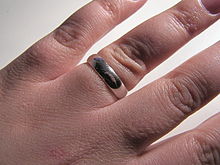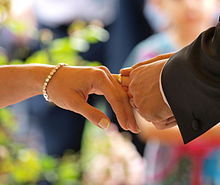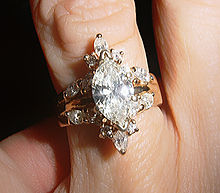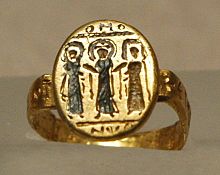The following article was sourced from a Wikipedia page at the following address: http://en.wikipedia.org/wiki/Wedding_ring
WEDDING RINGS

A white gold wedding ring
A wedding ring or wedding band is a ring, often but not always made of metal, indicating the wearer is married. Depending on the local culture, it is worn on the base of the right or the left ring finger. The custom of wearing such a ring has spread widely beyond its origin in Europe. In the United States, wedding rings were originally worn only by wives, but during the 20th century they became customary in that country for both husbands and wives. It is a tradition that goes back many centuries, having manifested in the wedding customs of many different nations and religious groups. They come in many forms, most traditionally a ring made of gold or some other precious metal.
HISTORY
Origins
It is widely believed that the first examples of wedding rings were found in ancient Egypt. Relics dating back as far as 3,000 years ago, including papyrus scrolls, show us evidence of braided rings of hemp or reeds being exchanged among a wedded couple. Egypt viewed the circle as a symbol of eternity, and the ring served to signify the never-ending love between the couple. This was also the origin of the practice of wearing the wedding ring on the ring finger of the left hand, which the Egyptians believed to house a special vein that was connected directly to the heart.
Historical ring styles
Gimmel rings
During the 1500s and 1600s, European husbands would bestow a gimmel ring upon their wives. Similar to the puzzle ring, they consisted of two interlocking bands. The bride and groom would each wear one of these bands after their engagement, and the two bands would be reunited at the wedding ceremony. The wife would then wear the combined ring.
Poesy rings
This was a style of ring that was popular during the Renaissance. It came in the form of a band of sterling silver, inscribed with a poem or similar expression of love.
Wedding thimbles
There is a modern belief that in early colonial New England, where Puritans shunned ornaments and jewels, a thimble substituted for both engagement ring and wedding ring; and some women would remove the tops of the thimble in order to create a ring. Some researchers strongly believe this to be just a myth without basis in reality.
Other ring styles
There are many other historical ring styles throughout different cultures. For example see the picture below of the Byzantine era ring depicting Christ. Also there are puzzle rings representing an old custom from the Middle East. This ring was made up of several pieces that would join up together in a cohesive band when worn correctly. The object of this ring was to be very difficult to put on properly so that, if the wife took off her wedding ring, her husband would know.
The introduction of the double-ring ceremony
The double-ring ceremony, or use of wedding rings for both partners, is a relatively recent innovation in the United States. The American jewellery industry started a marketing campaign aimed at encouraging this practice in the late 19th century. In the 1920s, ad campaigns tried introducing a male engagement ring, but it failed due to the necessity that its advertising campaigns make secret appeals to women. Marketing lessons of the 1920s, changing economic times, and the impact of World War II led to a more successful marketing campaign for male and female wedding bands, and by the late 1940s, double-ring ceremonies made up 80% of all weddings, as opposed to 15% before the Great Depression. In the 21st century 80% of the ceremonies still consist of double-ring ceremonies within the United States. However this trend may have lesser prevalence outside continental United States where it is still common to find weddings with just the bride wearing the wedding ring. Global marketing efforts by jewellery industry are increasingly encouraging the trend for double-ring weddings worldwide.
COMPOSITIONS AND STYLES
In Western countries, wedding rings are often made of white or yellow gold. Common engravings on the inside of the ring include the name of the partner or the names of both parts in the relationship, and/or date of the wedding.
According to some customs, the ring forms the last in a series of gifts, which also may include the engagement ring, traditionally given as a betrothal present. This custom was practised in Ancient Rome and is possibly much older.
RELIGION
Wedding ceremony customs
In several traditions, the best man or maid of honour has the duty of keeping track of a couple's wedding rings and to produce them at the symbolic moment of the giving and receiving of the rings during the traditional marriage ceremony. In more elaborate weddings, a ring bearer (who is often part of the family of the bride or groom) may assist in the ceremonial parading of the rings into the ceremony, sometimes on a special cushion.
Among Eastern Orthodox and Eastern Catholic Christians, the exchange of rings is not technically part of the wedding service, but rather are exchanged at the betrothal. It is always a two-ring set given to her by the priest or by the best man. The orthodox Christian Church of Greece has recently stopped performing betrothal blessings separately, as these were often non-committing, and now a betrothal ceremony is the initial part of the wedding service. In many families an informal blessing is now performed by the betrothed ones' parents in a family dinner that formalizes the betrothal. The ceremony of betrothal is now possibly performed immediately before the wedding (or "crowning" as it is more properly called), and the actual symbolic act of marriage is not the exchange of rings, but the public exchange of wedding vows.
In older times, the wedding rings were not only a sign of love, but were also linked to the bestowal of 'earnest money'. According to the 1549 edition of the Book of Common Prayer: after the words 'with this ring I thee wed' follow the words 'This gold and silver I give thee', at which point the groom was supposed to hand a leather purse filled with gold and silver coins to the bride.

A groom placing a wedding ring on the finger of his bride during a wedding ceremony

A gold banded engagement-wedding-anniversary ring combination welded together
Historically, the wedding ring was connected to the exchange of valuables at the moment of the wedding rather than a symbol of eternal love and devotion. It is a relic of the times when marriage was a contract between families, not individual lovers. Both families were then eager to ensure the economic safety of the young couple. Sometimes it went as far as being a conditional exchange as this old (and today outdated) German formula shows: 'I give you this ring as a sign of the marriage which has been promised between us, provided your father gives with you a marriage portion of 1000 Reichsthalers'.
Post-wedding customs
After marriage, the ring is worn on the hand it had been placed on during the ceremony. By wearing rings on the fourth finger, a married couple symbolically declares their eternal love for each other. This has become a matter of tradition and etiquette.
Some cultures exchange additional rings: In some parts of India, Hindus may use a toe ring or bichiya which is worn instead of a ring on a finger; although this is only for women, and increasingly worn along with a finger ring. In the eastern parts of India, primarily West Bengal, an iron bangle, or 'loha,' is worn by women. Increasingly, this bangle is given a gold or silver coating to improve its appearance. In Romania, spouses celebrate their silver wedding anniversary (25 years of marriage) by exchanging silver wedding rings, which are worn on the fourth finger of the left hand along with the original (usually gold) wedding ring.

Byzantine wedding ring, depicting Christ uniting the bride and groom, 7th century, nielloed gold (Musée du Louvre)
Wedding ceremonies that reference rings
- Church of England (1662 Book of Common Prayer): "With this ring I thee wed, with my body I thee worship, and with all my worldly goods I thee endow: In the Name of the Father, and of the Son, and of the Holy Ghost. Amen."
- Jewish: "You are consecrated to me with this ring according to the law of Moses and Israel."—said in Hebrew by the groom at an Orthodox Jewish wedding and by both the bride and groom at a Reform Jewish wedding.
- Roman Catholic: "N., take this ring as a sign of my love and fidelity. In the name of the Father, and of the Son, and of the Holy Spirit."
- Eastern Orthodox: In the Eastern Orthodox Service of Betrothal, the Priest makes the Sign of the Cross with rings over the bridegroom's head while saying three times "The servant of God (Groom) is betrothed to the handmaid of God (Bride), in the Name of the Father, and of the Son, and of the Holy Spirit. Amen". This is then followed by another three times over the bride's head with the names reversed, after which the rings are exchanged three times (either by the priest or by the best man). The Priest asks God "to bless this putting on of rings with a heavenly blessing and that an Angel of the Lord will go before these Your servants, all the days of their life." In Eastern Orthodox tradition the wedding ring is worn on the right hand rather than the left.
For more information on wedding rings, please click on the following link: http://en.wikipedia.org/wiki/Wedding_ring
